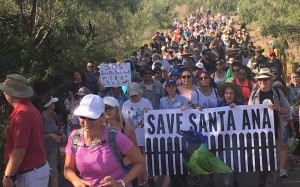
About 650 marchers protested the construction of a border barrier at Santa Ana National Wildlife Refuge in 2017.
[Updated]
By Bill Dawson
Texas Climate News
Some of the biodiversity-conservation sites in the Lower Rio Grande Valley of South Texas that are threatened by President Donald Trump’s border wall proposal got at least a temporary reprieve last week.
Rep. Henry Cuellar, a Democrat from Laredo, secured language protecting the areas from wall construction in the appropriations bill, passed by Congress and signed by Trump, that avoided another government shutdown and funds federal agencies for a year.
The wall has drawn fierce opposition for various reasons. Scientists and wildlife advocates have protested that the project would clear and divide protected habitat, doing great damage to the Valley’s rich, highly diverse, and vulnerable animal and plant life.
The region’s renowned biodiversity, especially noted for its world-recognized populations of birds and butterflies, has been the focus of decades of conservation efforts by private organizations and government. Agricultural and urban development have replaced the great majority of the Valley’s once-vast wildlife habitat.
As a result of the conservation drive in the region, a string of wildlife refuges, parks and other protected natural areas was created along and near the Rio Grande to protect remaining fragments of undeveloped land. New border-wall or other barrier construction would destroy some of the protected habitat that remains.
The statutory language secured by Cuellar, a member of the congressional House-Senate committee that hammered out the appropriations bill, forbids funding for physical border barriers in Santa Ana National Wildlife Refuge near Alamo, Bentsen-Rio Grande Valley State Park (headquarters of the World Birding Center) near Mission, and the private National Butterfly Center at Mission.
Cuellar’s language also protects the historical La Lomita chapel in Mission and a tract near Brownsville where the commercial SpaceX spaceport is planned.
However, other protected areas important for wildlife in the region could still be the sites of barrier construction.
The appropriations bill, while denying Trump most of the funding he wanted for wall and related work, did include $1.4 billion for border barriers. Fifty-five miles in the Valley are designated for such projects – roughly comparable to the barriers including fencing that are already in place along the Rio Grande there.
Work in preparation for barrier construction was reported last week in areas that were not made off-limits by Cuellar’s provision.
The Butterfly Center reported there was land-clearing activity on a unit of the Lower Rio Grande Valley National Wildlife Refuge west of the center’s own property. That federally owned and managed refuge comprises a string of small units along the Rio Grande that serves as a “wildlife corridor” for native and migrating species.
“(H)eavy equipment began clearing trees and brush from the La Parida Banco National Wildlife Refuge tract west of us,” the center said in an online update about its fight against border barriers on its property and elsewhere in the Valley. “The appliance being used for the clearing reduces a tree and every living creature in it to dust in about 60 seconds.”
Proponents of safeguarding all of the Valley’s wildlife-conservation sites expressed concern, as well, that the sites’ future status is clouded by Trump’s declaration of a national emergency on Friday to shift more than $6.5 billion in additional funds from congressionally approved projects – mainly military – to pay for border-barrier construction.
On Monday, 16 states sued to stop Trump’s invocation of emergency powers. The state’s action, combined with a separate lawsuit by conservation groups on Friday, sets off an expected and potentially lengthy court fight whose outcome Trump predicted would be decided by the Supreme Court.
If the emergency declaration survives court and congressional challenges, could it override the statutory protections secured by Cuellar and open those areas to barrier construction? Catholic News Agency, focusing on the implications for La Lomita Chapel, reported that there are conflicting opinions on that legal issue.
+++
Read TCN’s earlier coverage of the wall-and-wildlife issue in the Lower Rio Grande Valley:
A barrier to wildlife as well as people: Environmental costs of Trump’s wall
Border wall threatens ‘substantial’ harm to biodiversity, scientists warn
Secretive border-wall work at wildlife sanctuaries galvanizes opposition
Related coverage:
New studies: Migratory birds face multiple threats from climate change
+++++
Bill Dawson is the founding editor of Texas Climate News.
